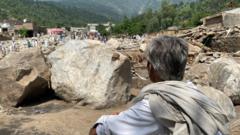The situation in Pakistan's northern regions has taken a grim turn as flash floods wreak havoc, claiming the lives of at least 314 individuals and injuring many more in recent days. The picturesque village of Bishnoi, nestled within the lush mountains, found its serene beauty devastated by a sudden surge of water on the morning of August 15.
According to eyewitness accounts, the floodwaters not only swept through the village but also brought along massive boulders, leading to catastrophic destruction. As community members and rescue personnel sift through the debris, they face daunting challenges while searching for survivors. "There is a house under every stone," local Israr Khan lamented, expressing the desperation of searching for loved ones.
The entire district of Buner, where the village lies, has become the hardest-hit region, with local disaster management officials reporting that over 217 lives were lost there alone. Many fatalities were reported to have occurred when floodwaters engulfed a house where a wedding ceremony was being prepared. Estimates suggest that nearly 50% of the houses in Bishnoi have been rendered uninhabitable due to the floods.
The monsoon season in South Asia, which typically runs from June to September, is notorious for triggering landslides and flooding. This year's rainy season has been particularly deadly, with over 650 lives claimed so far across the region. Since late June, Pakistan has witnessed rain-related incidents that have resulted in over 507 deaths and significant injuries.
As the water levels remain dangerously high, climate experts point to global warming as a factor exacerbating the frequency and severity of such extreme weather events. Despite no direct causative link established yet, glaciologists warn that melting glaciers are destabilizing the terrain, increasing the likelihood of landslides.
Authorities have signaled expectations of continued heavy rainfall in the northwest until August 21, adding further worries as several regions are declared disaster zones. In nearby Swat Valley, a quick-thinking school principal managed to evacuate nearly 900 students just moments before floodwaters struck, saving countless lives.
The tragedy extends beyond physical destruction, as families like Abdul Salam's have suffered profound losses; he tragically lost his wife and children in the floods. As corpses are discovered beneath the wreckage, reports indicate that in Buner alone, at least 27 villagers remain unaccounted for, and the community continues to confront the harrowing aftermath.
In the town of Buner, the scenes are grim; uprooted trees, flattened crops, and damaged infrastructures lay scattered along roadways. Relief agencies including Al-Khidmat are mobilizing to provide assistance, and military personnel are engaged in recovery efforts. Despite progress, the emotional toll on survivors and the families of victims is palpable as they grapple with the immense scale of the disaster and the urgency of ongoing search operations for those still missing.




















